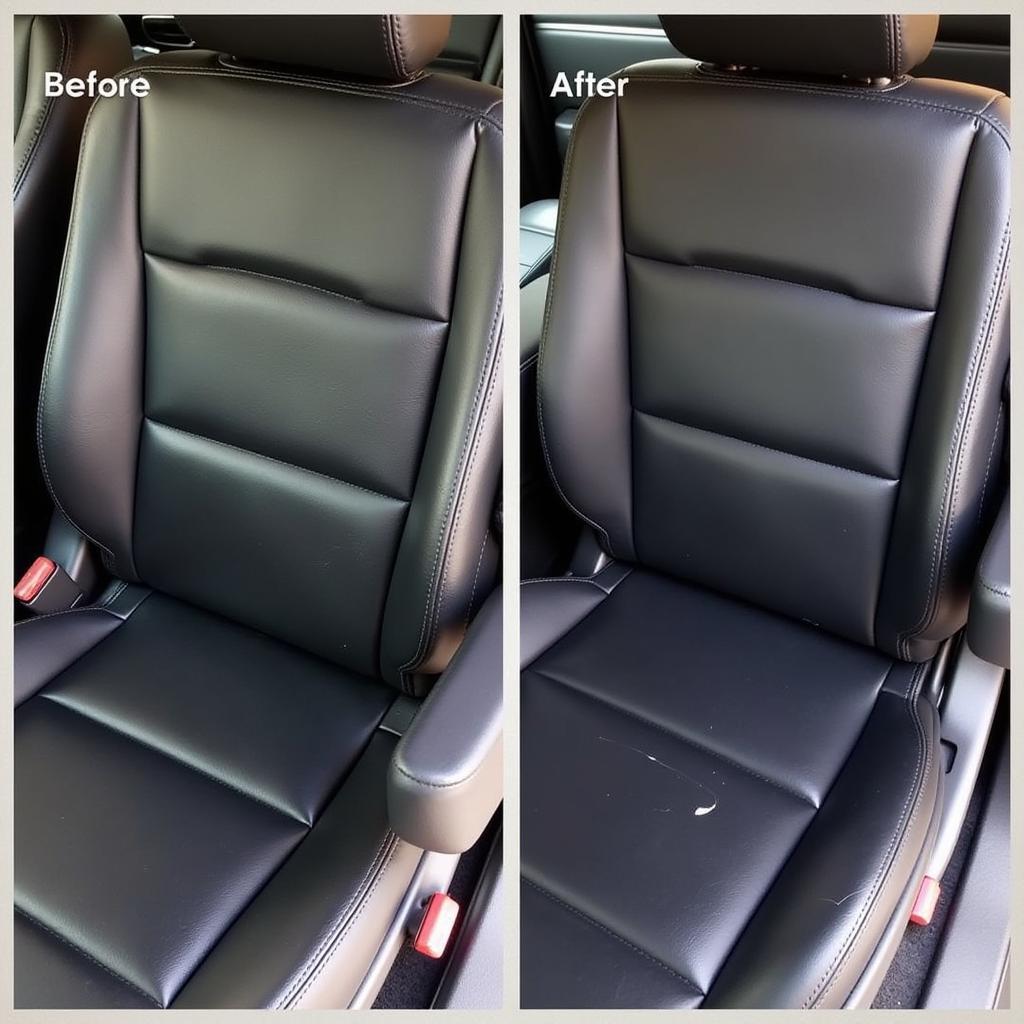Leather car seats, while luxurious and sophisticated, are prone to wear and tear. Tears, especially, can be an eyesore and diminish the overall aesthetic of your car’s interior. Fortunately, repairing these tears doesn’t always require a costly visit to an auto upholstery specialist. With the right approach and materials, you can restore your leather car seats to their former glory in the comfort of your own garage.
[image-1|leather-car-seat-tear-close-up|Close-up of a tear on a leather car seat|A close-up shot showcasing a significant tear on the driver’s seat of a car. The tear reveals the foam padding underneath and highlights the need for repair.]
Understanding Leather Car Seat Tears
Before diving into the repair process, it’s crucial to understand the nature of the damage. Leather car seat tears vary in severity and type.
- Small Cracks and Scratches: These are superficial and can often be addressed with leather conditioners or fillers.
- Minor Tears: These are small rips or punctures that haven’t significantly widened.
- Large Tears: These involve substantial damage, exposing the underlying padding and requiring more comprehensive repair techniques.
DIY Repair vs. Professional Help: When to Call the Experts
While minor tears and cracks can often be addressed with DIY solutions, significant damage necessitates professional intervention. Here’s a guide to help you decide:
DIY Repair:
- Small cracks, scratches, and minor tears
- Basic understanding of leather repair techniques
- Willingness to invest time and effort
Professional Help:
- Large, complex tears
- Extensive damage involving multiple panels
- Lack of experience or confidence in DIY repairs
[image-2|professional-upholsterer-repairing-car-seat|Professional upholsterer repairing a torn car seat|An experienced upholsterer meticulously works on a damaged car seat, demonstrating the level of expertise required for complex repairs.]
Essential Supplies for Leather Car Seat Repair
Gathering the necessary supplies beforehand ensures a smooth repair process. Here’s what you’ll need:
- Leather Cleaner: To thoroughly clean the affected area.
- Leather Repair Kit: These kits usually contain a color-matched filler compound, adhesive, a backing fabric, and application tools. You can find these online or at auto parts stores.
- Scissors: For trimming the backing fabric and any loose threads.
- Tweezers: Useful for precise application of the filler compound.
- Heat Gun or Hairdryer: To speed up the drying process of the filler compound.
- Leather Conditioner: To restore the leather’s suppleness and protect it after the repair.
Remember to choose a leather repair kit that closely matches the color of your car’s interior to ensure a seamless finish. You can find more information on the supplies you need in our comprehensive guide to car leather seat repair supplies.
A Step-by-Step Guide to Repairing Leather Car Seat Tears
Follow these steps to repair minor to moderate leather tears on your car seats:
- Clean the Area: Begin by cleaning the damaged area and surrounding leather with a dedicated leather cleaner. This removes dirt, grime, and debris that could compromise the repair’s effectiveness.
- Prepare the Tear: Trim any loose threads or frayed edges around the tear using sharp scissors. Be careful not to enlarge the tear further.
- Apply Backing Fabric (If Needed): For larger tears, cut a piece of backing fabric slightly larger than the tear from the repair kit. Apply a thin layer of adhesive from the kit to the back of the fabric and carefully place it underneath the tear, ensuring it lays flat.
- Fill the Tear: Using a palette knife or the applicator provided in the kit, carefully fill the tear with the leather filler compound. Apply multiple thin layers, allowing each layer to dry completely before applying the next. A heat gun or hairdryer on a low setting can speed up the drying process.
- Level the Surface: Once the filler compound is completely dry, use fine-grit sandpaper (1000 grit or higher) to level the repaired area with the surrounding leather. Sand gently in circular motions to avoid scratching the intact leather.
- Apply Colorant (If Necessary): Some repair kits come with a colorant to match the repaired area with the rest of the seat. If your kit includes this, apply it sparingly according to the manufacturer’s instructions.
- Condition the Leather: After the repair has dried and cured completely (usually 24 hours), apply a high-quality leather conditioner to the entire seat. This helps to rehydrate the leather, protect it from future damage, and blend the repaired area seamlessly.
[image-3|applying-leather-filler-compound-to-car-seat-tear|Applying leather filler compound to a car seat tear|A person carefully applies leather filler compound to a tear on a car seat, demonstrating the precision required for a successful repair.]
Tips for a Seamless Repair
- Patience is Key: Leather repair requires patience, especially when layering the filler compound. Rushing the process can compromise the results.
- Less is More: Apply the filler compound in thin layers to prevent cracking and ensure a smooth finish.
- Temperature Matters: Work in a well-ventilated area with moderate temperatures. Extreme heat or cold can affect the drying and curing process of the filler compound.
Preventing Future Tears
Prevention is always better than cure. Follow these tips to minimize the risk of future tears in your leather car seats:
- Regular Cleaning and Conditioning: Clean your leather seats regularly with a pH-neutral cleaner and condition them every few months to keep the leather supple and prevent drying and cracking.
- Avoid Sharp Objects: Be mindful of sharp objects like keys, pens, and tools that could potentially scratch or puncture the leather.
- Address Minor Damage Promptly: Don’t ignore minor cracks or scratches. Addressing them promptly with leather conditioner or filler can prevent them from developing into larger tears.
Conclusion
Repairing leather car seat tears doesn’t have to be a daunting task. By following these steps and arming yourself with the right information and tools, you can restore your car’s interior and maintain its value for years to come. Remember, while DIY repairs are suitable for minor damage, significant tears are best handled by professional upholsterers. For those located in Hertfordshire, you can find out more about the cost of professional car leather seat repair in our dedicated guide: car leather seat repair cost Hertfordshire.
FAQs
Q: Can I use super glue to repair a leather car seat tear?
A: No, super glue is not recommended for leather repair. It dries too rigidly and can worsen the tear over time.
Q: How long does it take for the leather filler compound to dry completely?
A: The drying time varies depending on the product and environmental conditions, but it usually takes 24 hours for complete curing.
Q: Can I repair a tear on a heated or cooled car seat?
A: It’s best to repair the tear when the heating or cooling function is turned off to prevent the filler compound from drying unevenly.
Q: Can I dye my leather car seats a different color during the repair process?
A: While it’s possible, dyeing leather requires specialized knowledge and products. It’s best left to professional upholsterers.
Q: How can I prevent my leather car seats from fading in the sun?
A: Park your car in the shade whenever possible and use a sunshade on the windshield to minimize UV exposure.
Need further assistance with your car leather seat repairs?
We’re here to help! Contact us via WhatsApp: +1(641)206-8880 or Email: [email protected]. Our dedicated customer support team is available 24/7 to answer your questions and provide guidance.
You can also find more helpful tips and guides on our website, including specific information on repairing leather car seat rips: how to repair leather car seat rips. For those in the Grimsby area, we also have a dedicated guide to car leather seat repairs in your area: car leather seat repairs grimsby.


